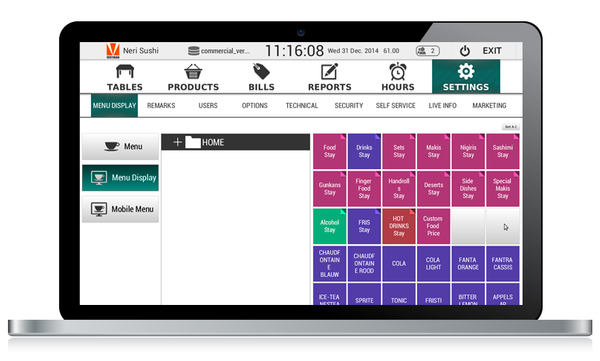How POS System Works: A Comprehensive Guide for Entrepreneur
A POS system works as a crucial device for modern-day businesses, integrating numerous elements to enhance procedures. It includes equipment like barcode scanners and software program available tracking. This system not just processes deals yet also handles inventory and evaluates client actions. Comprehending its capability can significantly affect a service's performance and decision-making. What are the crucial elements that add to this efficiency? Exploring these components offers valuable insights.
Comprehending the Elements of a POS System
A Point of Sale (POS) system is made up of several key components that interact to facilitate deals and handle business operations. At its core, the equipment consists of gadgets such as a sales register, barcode scanner, receipt printer, and repayment terminal, all crucial for refining sales (Restaurant POS Software). The software program component manages inventory, sales monitoring, and customer information, providing beneficial insights for service decisions.Additionally, data sources keep purchase records and customer info, ensuring data stability and safety. Network connection allows real-time updates and accessibility to cloud-based services, improving operational performance. Interface, created for ease of use, enable team to browse the system promptly, lessening training time. Together, these parts create a natural system that simplifies the sales process, enhances customer solution, and aids in efficient management of business sources. Comprehending these components is important for local business owner looking for to optimize their POS systems
Just How Sales Purchases Are Processed
When a client chooses to buy, the sales deal starts a series of methodical steps within the POS system. First, the cashier inputs the items being bought, which are checked via a barcode reader or by hand gone into. This activity recovers product details, including rates and relevant tax obligations, from the system's database.Next, the consumer is offered with the total quantity due. The POS system then refines the settlement, whether via cash, charge card, or mobile payment techniques. For digital repayments, the POS securely communicates with settlement processors to license and verify the transaction.Once the settlement is confirmed, the system generates a receipt, which can be published or sent digitally. This invoice works as receipt for the client. Ultimately, the deal information is videotaped in the system, ensuring exact sales documents and monetary monitoring for business.
Inventory Management and Tracking
Efficient stock monitoring and monitoring are vital components of a POS system, as they guarantee that businesses maintain ideal stock degrees and minimize discrepancies. A robust POS system enables real-time stock updates, reflecting sales and returns instantaneously. This enables organization owners to check supply degrees properly, guaranteeing that preferred products are conveniently available while stopping overstocking of less prominent products.Additionally, advanced POS systems offer attributes such as computerized stock signals and reorder ideas, enhancing the procurement process. Barcoding and RFID modern technology boost accuracy in tracking supply motion, lowering human error. Extensive coverage devices provide insights into supply turn over prices, assisting services make notified choices concerning purchasing and product offerings. Ultimately, effective useful site stock management through a POS system not only enhances functional effectiveness however additionally boosts customer satisfaction by guaranteeing item accessibility.

Evaluating Consumer Data and Insights
Customer data evaluation offers as an effective tool for businesses using a POS system. By accumulating and analyzing purchase information, services can discover important insights about client habits and preferences. This evaluation allows them to recognize acquiring patterns, peak buying times, and preferred products, thereby informing inventory decisions and advertising strategies.Additionally, companies can segment their customer base, enabling customized advertising and marketing initiatives that deal with details demographics or purchasing routines. Recognizing consumer loyalty patterns likewise assists in creating targeted promotions and incentives programs.The data gleaned from a POS system can additionally disclose understandings right into consumer comments, enabling businesses to make enlightened decisions pertaining to item offerings and solution renovations. Inevitably, leveraging consumer data effectively can enhance the total purchasing experience, foster consumer contentment, and drive revenue development.
Advantages of Implementing a POS System
Carrying out a POS system uses numerous benefits that can considerably enhance organization procedures. To begin with, it enhances transaction processes, lowering delay times and improving consumer satisfaction. By automating sales procedures, companies can reduce human mistake and guarantee precise record-keeping. In addition, a POS system provides valuable data analytics, allowing proprietors to track sales patterns and supply degrees in real-time. This insight supports educated decision-making, assisting to maximize supply administration and advertising strategies.Moreover, several POS systems incorporate with various other service tools, such as accountancy software application, simplifying economic monitoring. Enhanced employee monitoring attributes, such as tracking hours and performance, additional add to functional efficiency.Lastly, the application of a POS system can cause increased income with improved client experiences and calculated understandings, ultimately fostering business growth and sustainability.
Regularly Asked Concerns
What Sorts Of Companies Can Benefit From a POS System?

Just how much Does a POS System Typically Price?
The cost of a POS system typically ranges from a few hundred to several thousand dollars, relying on attributes, hardware, and software - Restaurant POS Software. Organizations should consider ongoing fees for maintenance, official statement assistance, and purchase processing when check budgeting

Can I Incorporate a POS System With Existing Software?
Incorporating a POS system with existing software application is often possible. Many systems offer APIs or integrated compatibility attributes, permitting companies to streamline procedures and improve performance by connecting various software applications effectively.
What Training Is Required for Personnel to Use a POS System?
Educating for staff to make use of a POS system normally includes understanding software capabilities, refining deals, taking care of inventory, and taking care of client communications - Restaurant POS Software. Practical demonstrations and hands-on practice improve efficiency and confidence being used the system efficiently
What Takes place if the Internet Drops While Making Use Of a POS System?
If the net goes down throughout POS system usage, transactions might be disrupted. Several systems provide offline capabilities, allowing standard operations to continue, yet complete performance, consisting of real-time supply updates, will certainly be limited.